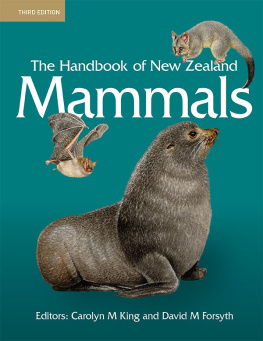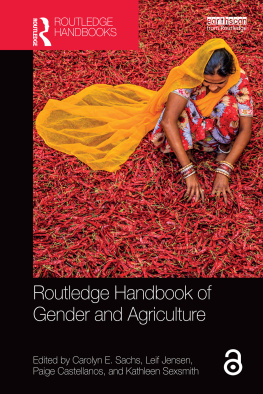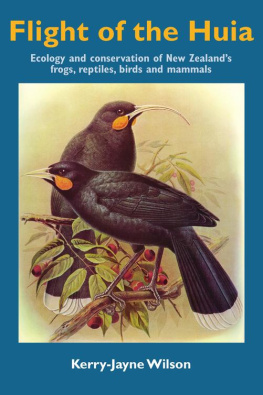Carolyn M King - The Handbook of New Zealand Mammals
Here you can read online Carolyn M King - The Handbook of New Zealand Mammals full text of the book (entire story) in english for free. Download pdf and epub, get meaning, cover and reviews about this ebook. year: 2020, publisher: CSIRO Publishing, genre: Politics. Description of the work, (preface) as well as reviews are available. Best literature library LitArk.com created for fans of good reading and offers a wide selection of genres:
Romance novel
Science fiction
Adventure
Detective
Science
History
Home and family
Prose
Art
Politics
Computer
Non-fiction
Religion
Business
Children
Humor
Choose a favorite category and find really read worthwhile books. Enjoy immersion in the world of imagination, feel the emotions of the characters or learn something new for yourself, make an fascinating discovery.
- Book:The Handbook of New Zealand Mammals
- Author:
- Publisher:CSIRO Publishing
- Genre:
- Year:2020
- Rating:3 / 5
- Favourites:Add to favourites
- Your mark:
- 60
- 1
- 2
- 3
- 4
- 5
The Handbook of New Zealand Mammals: summary, description and annotation
We offer to read an annotation, description, summary or preface (depends on what the author of the book "The Handbook of New Zealand Mammals" wrote himself). If you haven't found the necessary information about the book — write in the comments, we will try to find it.
The Handbook of New Zealand Mammals — read online for free the complete book (whole text) full work
Below is the text of the book, divided by pages. System saving the place of the last page read, allows you to conveniently read the book "The Handbook of New Zealand Mammals" online for free, without having to search again every time where you left off. Put a bookmark, and you can go to the page where you finished reading at any time.
Font size:
Interval:
Bookmark:


Copyright The Authors 2021. All rights reserved.
Except as permitted by applicable copyright laws, no part of this publication may be reproduced, stored in a retrieval system or transmitted in any form or by any means, electronic, mechanical, photocopying, recording, duplicating or otherwise, without the prior permission of the copyright owner. Contact CSIRO Publishing for all permission requests.
The authors and editors assert their moral rights, including the right to be identified as an author or editor.
A catalogue record for this book is available from the National Library of Australia.
ISBN: 9781486306282 (hbk)
ISBN: 9781486306299 (epdf)
ISBN: 9781486306305 (epub)
Published in Australia in print only, and in all other formats throughout the world, by CSIRO Publishing.
CSIRO Publishing
Locked Bag 10
Clayton South VIC 3169
Australia
Telephone: +61 3 9545 8400
Email:
Website: www.publish.csiro.au
A catalogue record for this book is available from the National Library of New Zealand.
ISBN 978-1-98-859258-9
Published in New Zealand and the rest of the world (excluding Australia), in print only, by Otago University Press.
Otago University Press
Te Whare T o Te Wnanga o tkou
533 Castle Street
Dunedin, New Zealand
www.otago.ac.nz/press
Front cover: brushtail possum, grey form; lesser short-tailed bat; New Zealand fur seal (artwork by Priscilla Barrett)
Back cover: Himalayan tahr male, winter (artwork by Priscilla Barrett)
Edited by Joy Window (Living Language)
Cover design by James Kelly
Typeset by Envisage
Printed in China by Leo Paper Products Ltd.
CSIRO Publishing publishes and distributes scientific, technical and health science books, magazines and journals from Australia to a worldwide audience and conducts these activities autonomously from the research activities of the Commonwealth Scientific and Industrial Research Organisation (CSIRO). The views expressed in this publication are those of the author(s) and do not necessarily represent those of, and should not be attributed to, the publisher or CSIRO. The copyright owner shall not be liable for technical or other errors or omissions contained herein. The reader/user accepts all risks and responsibility for losses, damages, costs and other consequences resulting directly or indirectly from using this information.
The paper this book is printed on is in accordance with the standards of the Forest Stewardship Council and other controlled material.
The FSC promotes environmentally responsible, socially beneficial and economically viable management of the worlds forests.

The Handbook of New Zealand Mammals was first published by Oxford University Press (Auckland) in New Zealands sesquicentennial year of 1990, and launched at a celebration funded by the 1990 Commission in Wellington. The Handbook followed 40 years after the first substantial book about mammals in New Zealand, Introduced Mammals of New Zealand: An Ecological and Economic Survey by Kazimierz Wodzicki, which was published in 1950. Ten years after the first edition of The Handbook of New Zealand Mammals, a series of reviews was commissioned, and published under the general heading of Advances in New Zealand Mammalogy 19902000 as a special issue of the Journal of the Royal Society of New Zealand in 2001. Fifteen years after the first edition, a full second edition integrated and further updated the 1990 and 2001 texts. Now, a further 15 years later, we have revisited and updated the texts for a third edition, scheduled to appear in early 2021.
As a comprehensive reference book, the first Handbook was cast in the same mould as Wodzickis pioneering volume, but different from it in one important aspect: the inclusion of introduced and native mammals in the same tome. There were objections to this decision from conservation activists, on the grounds that it seemed to extend a tacit acceptance of the introduced species. However, the practical and scientific reasons for including native and introduced species together won the debate. The ready reception and wide use of the book since then has confirmed that view.
The first edition of the Handbook was reprinted as a paperback, with minor corrections, in 1995, and again, in new covers, in 1998. Oxford University Press in Auckland and (after 1999) in Melbourne published the first and second editions. The third edition has been prepared by CSIRO Publishing in Melbourne.
The extensive information collected by the authors for each edition includes much material previously unpublished or gathered from inaccessible or widely scattered sources. The combined literature list for the first edition (~1600 entries) closed in September 1987, when the paper manuscript was handed over to the publisher (a few later citations were added in proof). The combined list for the second edition totalled almost 3000 entries, and closed in late 2004. The lists for the third edition are now separated into family sections. This rapid increase in information to be reviewed, and in the speed of handling it, reflects the many exciting advances in technology that have accompanied the electronic revolution of the last 30 years.
The Handbook of New Zealand Mammals has always had two aims: first, to collate for convenient reference authoritative, fully documented descriptions of all the land-breeding mammals that are or have been resident in New Zealand; and, second, to stimulate new research.
Many hypotheses suggested in earlier editions have since been tested. Some ideas developed overseas can be more effectively investigated in New Zealand than elsewhere; nevertheless, some questions of taxonomy or even basic biology remain to be examined. Readers might also detect differences of opinion between contributors, which have been allowed to stand because they can be resolved only by further research.
Island distributions are often dynamic, especially for species that are good swimmers, so the listings of island distributions are here mostly confined to islands of >5 ha supporting more or less permanent populations. No doubt many such populations remain unlisted, because it is simply impossible to do enough regular surveys to find them all.
The Handbook of New Zealand Mammals is not, however, an introduction to the biology of mammals in general, which is better described in a general reference work or a field guide. Neither is it a compendium of techniques for the study of mammals, for which readers should follow up the detailed references given in the species accounts.
All known land-breeding mammals that are or have been recorded in the wild in the New Zealand region (including the Ross Dependency, Antarctica) are described, including introductions that survived for at least 25 years but have since become extinct (kur, black-striped wallaby, chital deer); and feral populations of domestic stock that are or have been established for that long. One failed native vagrant, the little red flying fox, is mentioned in its family context (Chapter 4).
Font size:
Interval:
Bookmark:
Similar books «The Handbook of New Zealand Mammals»
Look at similar books to The Handbook of New Zealand Mammals. We have selected literature similar in name and meaning in the hope of providing readers with more options to find new, interesting, not yet read works.
Discussion, reviews of the book The Handbook of New Zealand Mammals and just readers' own opinions. Leave your comments, write what you think about the work, its meaning or the main characters. Specify what exactly you liked and what you didn't like, and why you think so.










